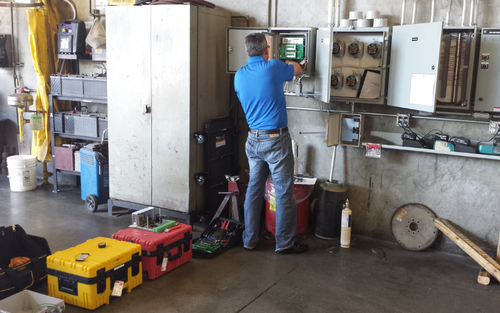Best Practices for Fixed Gas Detector Installation: Placement, Location, and Maintenance
The reliability and accuracy of gas monitors depend on where you place them. Keep reading to learn about optimal fixed gas detector placement and location.
Fixed gas detectors play a critical role in ensuring safe environments in various industries and commercial establishments. When properly installed and maintained, these detection systems can provide early warnings of gas leaks, allowing for timely evacuation and other prompt corrective actions.
For example, an article written in Manufacturing.net about a recent chemical leak that killed six workers at a poultry plant in Georgia could have been prevented if fixed gas monitors were used, along with other safety measures. According to the article by Russ Bynum, “a poorly designed freezer that spilled deadly liquid nitrogen as well as a failure by the plant's owner to install safety equipment and properly train employees for emergencies,” was the cause of the tragic accident, according to authorities.
For these instruments to perform their functions as intended, you also need to consider the optimal fixed gas detector placement and location. This article outlines some of the best practices and safety guidelines for fixed gas detector installation, focusing on the primary considerations for placement, location, and maintenance.
Placement Considerations
Identify Potential Hazard Zones
Before installing fixed gas detectors, thoroughly assess the facility to identify potential atmospheric hazards, leak sources, and hazard zones. Pay close attention to areas where toxic gases are stored, processed, or generated. This could include storage rooms, boiler rooms, and other confined spaces. Meanwhile, potential discharge points could include valves, pipes, ignition sources, and fittings.
Avoid Obstructions
Ensure that detectors have a clear line of sight to potential hazard sources. Avoid placing them behind obstacles like large equipment, storage containers, and other structural elements. This allows the sensors to detect gas leaks and alert employees promptly.
Consider Environmental Factors
Take into account environmental conditions that may affect gas dispersion, including factors such as:
- Temperature
- Humidity
- Airflow patterns
These factors can impact gas concentration levels. Install detectors in areas where these conditions are relatively stable to ensure accurate readings.
For example, positioning gas detectors near exhaust ducts ensures the air coming near the sensors is from the monitored area. In contrast, avoid installing detectors near ventilation intakes and entrances as the air passing through the sensors won’t represent the concerned area.
Location Considerations
Height and Mounting
The atmospheric hazards you’re monitoring dictate the height and mounting of your gas detectors. For instance, higher-density gases like gasoline and propane, are three to four times heavier than air. This means gas detectors should be installed within inches of the floor.
Conversely, if gases lighter than air, such as hydrogen and methane, are the concern, your fixed gas detection devices should be closer to the ceiling. Place the detectors within the breathing zone, four to six feet from the floor, to monitor gases with a similar density to oxygen.
Here’s a quick reference for fixed gas monitor placement:
- Floor Level: Carbon dioxide, diesel fuel, ethanol, refrigerants, benzene
- Breathing Zone: Carbon monoxide, hydrogen sulfide, chlorine, hydrogen chloride, formaldehyde, ammonia, sulfur dioxide, nitric oxide
- Ceiling Level: Hydrogen, Methane
If you have questions about the density of specific gases, ask your gas detection safety supply retailer.
Area Coverage
Refer to the manufacturer’s guidelines for specific recommendations on the optimal distance between gas monitors based on sensor capabilities. Keep in mind that your primary consideration should always be the hazard zones identified during the assessment.
If your budget permits, aim for a slight overlap between the detection zones of adjacent detectors. This prevents gaps where a potential gas leak could go undetected.
For optimal safety, consult a qualified professional with expertise in gas dispersion and mapping out the
best locations for gas detection systems. Together with the internal safety manager, they can iron out all considerations relevant to the workflow and operations of the facility.
Accessibility
Choose locations that are easily accessible for routine maintenance, bump tests, and calibration. Ensure personnel can reach detectors safely without needing specialized equipment or extensive dismantling.
Additionally, your gas detection system’s control panel should be positioned outside hazardous areas to allow personnel to view the gas levels from the controller post-evacuation.
Maintenance Guidelines
Regular Testing and Calibration
Establishing a routine gas detector calibration and testing schedule helps ensure that detectors function properly and provide accurate readings. Workplace safety professionals generally agree that you should always calibrate according to the manufacturer’s recommendations.
If you’re outsourcing gas detection management, make sure regular maintenance service and calibration are included in the agreement.
Inspect Sensors and Alarms
Regularly inspect sensors for signs of contamination, corrosion, or physical damage. Additionally, test the alarm functionality to verify that it responds appropriately to gas concentrations. Addressing any issues promptly maintains the detectors’ accuracy and reliability for their entire lifespan.
Keep Records
Maintain detailed records of all maintenance activities, including bump tests, calibration, inspections, and any necessary repairs. These records serve as documentation of compliance with industry standards and can be invaluable for auditing purposes.
Adhering to these practices and fixed gas detector maintenance tips enhances the safety of your facility and protects the well-being of all individuals within it. Remember that safety is an ongoing commitment, and regularly monitoring and maintaining fixed gas detection equipment are essential to the safety of your employees.
For any gas detection system installation and maintenance questions, contact our workplace safety experts at PK Safety.
Recent Posts
-
Customizing Gas Detectors: Tailoring Solutions to Fit Your Unique Requirements
In today’s diverse industrial landscape, a one-size-fits-all approach to safety simply doesn’t cu …Jul 3rd 2024 -
10 Ways to Prevent Wildfires
You can prevent wildfires by extinguishing flames before you leave the worksite. Avoid practicing …Jul 1st 2024 -
ANSI/ISEA 138 Safety Gloves: Ensuring Hand Protection
The human hand is an anatomical masterpiece and arguably the greatest tool attached to our bodies …Jun 25th 2024





